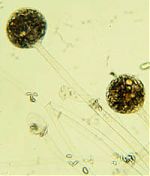Spinellus
SPINELLUS van Tieghem, 1875 (Ann. Sci. Nat., Bot., Sér. VI, 1:66) (van Tieghem, 1875—illus.; Vuillemin, 1904a—illus., 1905; Indoh, 1961—illus.; Ellis and Hesseltine, 1962; Watson, 1962, 1964—illus., 1965; Zycha et al., 1969—illus. and KEY TO SPP.; O’Donnell, 1979—illus.)
Species of Spinellus are facultative mushroom parasites (especially of Mycena and Collybia) in nature that produce simple sporangiophores that produce apophystate, multispored sporangia. Zygospores are produced on spinose zygophores. The suspensors are opposed, more or less equal, and nearly the same size as the zygospore. The zygosporangium is rough-walled.
Type species: S. fusiger
Species of Spinellus:
S. arvernensis Ling-Young, 1930 [Revue générale de Botanique 42:738 [no illustration])
S. chalybeus (Dozy & Molkenboer) Vuillemin, 1904 (Ann. Mycol. 2:61).
S. fusiger (Link) van Tieghem, 1875 (Ann. Sci. Nat., Bot., Sér. VI, 1:67).
S. gigasporus Cooke & Massee, 1892 (in Cooke, Handbook of Australian Fungi, p. 8).
S. sphaerosporus van Tieghem, 1875 (Ann. Sci. Nat., Bot., Sér. VI, 1:75).
Spinellus is characterized by the formation of multispored, relatively large sporangia on unbranched sporangiophores that arise from the cap of the host mushroom. Zygospores are produced on opposed, more or less equal suspensors borne on branched, spinose zygophores. Spinellus spp. are homothallic.
Spinellus species are facultative parasites of mushrooms in nature, especially Mycena spp. (Zycha et al., 1969). The first reports of the growth of Spinellus in culture were published early in the 20th century (Ellis and Hesseltine, 1962). Later, Spinellus was isolated from infected mushroom tissue that was placed on malt extract-glucose-peptone agar. Spore germination was slow but Spinellus grew from the mushroom cap; the sporangiophores eventually were 5 to 6 cm long (Ellis and Hesseltine, 1962). Watson (1962) isolated Spinellus sp. from infected Mycena galopus basidiocarps on a glucose-salts-yeast extract culture medium, and she induced spore germination by placing spores on basidiomes infected with bacteria. Leadbeater and Richardson (1963) isolated both Spinellus macrocarpus and S. fusiger using only spores as the inoculum. Best germination and growth occurred between 15 and 22 C whereas sporangiospores would germinate between 10 and 22 C; the highest temperature for germination and growth of S. fusiger is 27 C. Two culture media, cornsteep-sucrose agar and bread-filter paper-malt extract agar, produce good growth and sporulation of both Spinellus spp. Zygospores also formed on these culture media. Watson (1964) found that several compounds stimulated the germination of Spinellus macrosporus sporangiospores but ascorbic acid probably was the chemical in the host mushrooms. Walson (1965) found that thiamine and nicotinic acid were required by Spinellus.
Watson (1962) found that spore shape was different in cultures grown at 13 C versus 22.5 C (length:width ratio was 3:1 [13 c] versus 2:1 [22. 5 C]). Strid (1974), in various collections that he made in Norway and Sweden, observed differences in spore length which also corresponds to a difference in morphology. Spore length and morphology have been used to differentiate between species of Spinellus.
Spinellus is psychrotolerant and, therefore, can be found only in colder areas (Overton 1997). Zycha et al. (1969) includes five species in Spinellus but Overton (1997) recognized three ( S. chalybeus, S. fusiger, S. macrocarpus ) in North America but only S. fusiger appears to be in culture collections. Spinellus was transferred to Phycomycetaceae by von Arx (1982).
Bibliography
Ellis, J.J., and C.W. Hesseltine. 1962. Rhopalomyces and Spinellus in pure culture and the parasitism of Rhopalomyces on nematode eggs. Nature 193:699-670.
Indoh, H, 1961. On the genus Spinellus, one of fungicolous Phycomycetes, found in Japan. J. Japan. Bot. 36:201-204.
Leadbeater, G., and M. Richardson. 1963. Spinellus in pure culture. Nature 198:1015.
Ling-Yong (as Young), M. 1930. Étude biologique des phénomènes de la sexualité chez les Mucorinées. Rev. Gen. Bot., Paris 42:722-752.
O’Donnell, K.L. 1979. Zygomycetes in culture. Palfrey Contributions in Botany. No. 2. Department of Botany, University of Georgia, Athens, Georgia. 257 p.
Overton, B.E. 1997. Notes on the genus Spinellus with comparisons to other Zygomycetes found in fungicolous associations with Basidiomycetes. M.S. Thesis, Southern Illinois Universty, Carbondale, Illinois. 128 p.
Strid, Å. 1974. On the fungicolous phycomycetes Spinellus fusiger (Link) van Tiegh. Årsskrift [Journal of the Göteborgs Svampklubb] 1974:5-15.
van Tieghem, P. 1875. Nouvelles recherches sur les Mucorinées. Ann. Sci. Nat., Bot., Sér. VI, 1:5-175.
von Arx, J.A. 1982 [1984]. On Mucoraceae s. str. and other families of the Mucorales. Sydowia 35: 10-26.
Vuillemin, P. 1904a. Les Spinellus chalybeus (Dozy et Molkenboer) Vuillemin et la série des Spinellées. Annales Mycologique 2:61-69.
Vuillemin, P. 1904b. Recherches morphologiques et morphogéniques sur la membrane des zygospores. Annales Mycologici 2:483-506.
Vuillemin, P. 1905. Le Spinellus macrocarpus, et ses relations probables avec le Spinellus chalybeus. Ann. Mycol. 3:155-159.
Watson, P. 1962. Culture of Spinellus. Nature 195:1018.
Watson, P. 1964. Spore germination in Spinellus macrocarpus. Trans. Brit. Mycol. Soc. 47:239-245.
Watson, P. 1965. Nutrition of Spinellus macrocarpus. Trans. Brit. Mycol. Soc. 48:73-80.
Zycha, H., R. Siepmann, and G. Linnemann. 1969. Mucorales eine Beschreibung aller Gattungen und Arten dieser Pilzgruppe. Lehre, J. Cramer. 355 p.
Updated Mar 12, 2005

